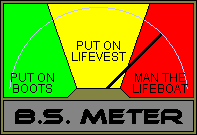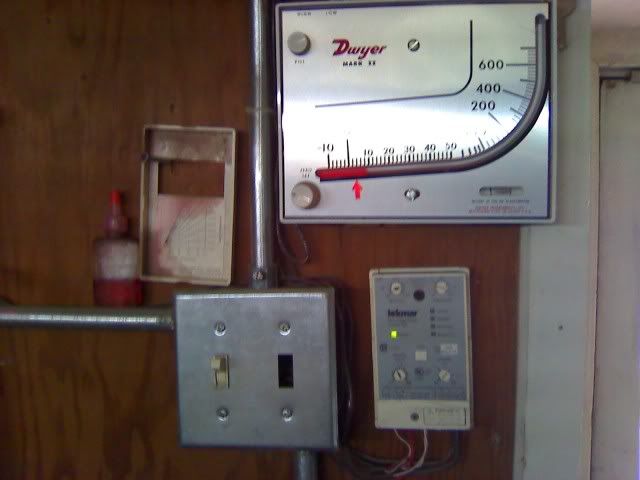Page 1 of 3
Now That's Some Wind!
Posted: Thu. Dec. 20, 2012 8:56 pm
by lsayre
I just watched my manometer hit 0.1" with the barometric damper wide open. It begins opening at 0.05" and is wide open soon after. That means cold weather is on the way.
Re: Now That's Some Wind!
Posted: Thu. Dec. 20, 2012 9:00 pm
by Rob R.
Keep an eye on the boiler temperature.
Re: Now That's Some Wind!
Posted: Thu. Dec. 20, 2012 9:06 pm
by lsayre
I imagine the dump zone will be seeing some action tonight. It's rare times like this that make me wonder if a second barometric damper set to begin opening at 0.06" would be worth while.
Re: Now That's Some Wind!
Posted: Thu. Dec. 20, 2012 9:46 pm
by Lightning
I am (was) seeing spikes over .1" WC too with the baro wide open. I have a manual damper on my pipe between the baro and furnace (furnace -> mano -> MPD -> baro-> chimney). I closed the manual about 80% which is keeping the spikes under a .05" WC and settles to a .02" WC between wind gusts.
lsayre wrote:It's rare times like this that make me wonder if a second barometric damper set to begin opening at 0.06" would be worth while.
I've wondered about a second baro also, but since the manual seems to be cutting the spikes down - I guess that will do

Re: Now That's Some Wind!
Posted: Thu. Dec. 20, 2012 9:56 pm
by freetown fred
Snowin & blowin like a bastard here on the hill. The old Hitzer just keeps plugging along with MPD closed as always with winter almost here. House is at 72* & I'm a happy camper.
Re: Now That's Some Wind!
Posted: Thu. Dec. 20, 2012 10:24 pm
by Sting
Those spikes are caused by vacuum not pressure
- you have too low - or negative atmospheric pressure in the boiler room because you don't have enough make up air - it not that the barrow is too small
Re: Now That's Some Wind!
Posted: Fri. Dec. 21, 2012 6:17 am
by Lightning
Sting, I don't quite understand. I'm thinking a lower atmospheric pressure in the boiler room would cause the opposite. Since high pressure migrates to lower pressure, air from outside would find its way in by coming down the chimney.
Due to my experience with flying, I believe the spikes are caused from the top of the chimney behaving somewhat similar to the air foil of a wing. As air (wind) is forced to bend up over the chimney top, it creates low pressure underneath it, which results in a pulling of exhaust up thru the chimney.
But thats my own hunch, feel free to add grains of salt to it lol...
Re: Now That's Some Wind!
Posted: Fri. Dec. 21, 2012 7:28 am
by stovepipemike
When I started breakfast at 0500 this morning it was 50 degrees.Munched up the corn flakes and downed a cup of coffee and it had dropped to 44 degrees,just that fast,6 degrees. I am hoping this front will get out of here and my hands will again be able to wrap around a coal shovel without protesting. Mike
Re: Now That's Some Wind!
Posted: Fri. Dec. 21, 2012 9:07 am
by lsayre
A simplistic verbalization of 'Bernoulli's Principle' states that (from memory): "Where velocity is high pressure is low, and where velocity is low pressure is high." (this being for pressures measured at 90 degree angles to the pertinent velocity medium [that which is flowing], be it gas or liquid)
I'm not sure how to equate this to chimneys and combustion air supplies, but I'll toss it into the mix anyway.
Re: Now That's Some Wind!
Posted: Fri. Dec. 21, 2012 9:37 am
by SMITTY
Wind is HOWLING out there today! Last night around midnight we had a sudden snow squall that left about an inch to 2" over everything by this morning. It's already melted, and the 10 minute average wind speed according to my weather station is 9 mph!
Re: Now That's Some Wind!
Posted: Fri. Dec. 21, 2012 10:25 am
by lsayre
I'm at work right now (plus I don't have any ping-pong balls) so I can't test this, but I have dreamed up a Bernoulli's Principle thought experiment.
Take a piece of pipe and a ping-pong ball. The pipes diameter should be less than the diameter of the ping-pong ball. The pipe is a chimney simulator. The ping-pong ball is the flue gas and fly ash, etc.... Hold the pipe vertically. Blow across (not into) the top of the pipe (thats the wind blowing across the top of the chimney) and then at the same time place the ping-pong ball near the bottom of the pipe. The velocity of the air blowing across the top of the pipe should create a low pressure area at a 90 degree angle to the flow, and the ping-pong ball (the gasses from the stove) should be drawn upward and sucked up against the bottom opening of the pipe as a consequence.
Re: Now That's Some Wind!
Posted: Fri. Dec. 21, 2012 10:32 am
by freetown fred
Re: Now That's Some Wind!
Posted: Fri. Dec. 21, 2012 10:45 am
by lsayre
All work and no play makes Jack a dull boy.
Fred, will you try the experiment and report your findings? The pipe can alternately be a bit larger than the ping-pong ball , and if this works it should get sucked right up through the pipe.
Re: Now That's Some Wind!
Posted: Fri. Dec. 21, 2012 11:47 am
by Lightning
Larry, cool experiment

I don't think you will persuade Fred to blow on a pipe though hahaha.. I've confirmed your experiment by blowing on the manometer tube the same way you've described and it does in fact read a negative pressure

So yes, on a larger scale such as with a chimney, the same rules apply.
Your experiment may be easier to illustrate with a small flat piece of paper and a paper towel tube since a ping pong ball may be too heavy. The paper should stay put to the bottom of the tube while you blow across the top.
Re: Now That's Some Wind!
Posted: Fri. Dec. 21, 2012 12:06 pm
by Sting
Lightning wrote:Sting, I don't quite understand. I'm thinking a lower atmospheric pressure in the boiler room would cause the opposite. Since high pressure migrates to lower pressure, air from outside would find its way in by coming down the chimney.
Due to my experience with flying, I believe the spikes are caused from the top of the chimney behaving somewhat similar to the air foil of a wing. As air (wind) is forced to bend up over the chimney top, it creates low pressure underneath it, which results in a pulling of exhaust up thru the chimney.
But thats my own hunch, feel free to add grains of salt to it lol...
well maybe

I am no engineeeeeerrrrrrr type fellow -

I got my edumkation at:

so try opening a window in the boiler room and see if there is a pressure change or not




